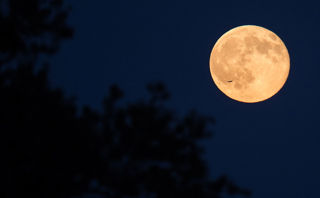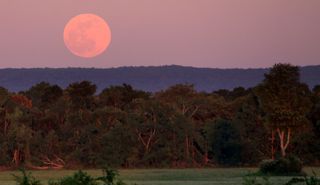
Full Moons and Full Facts
- 17th Mar 2022
- Author: Michael Darch
Our Moon goes by many names: Luna, Lune, Mond, Selene. But no matter where you are from or what you call our beautiful neighbour, the Moon is a shared human experience.
The Earth and Moon’s explosive first meeting
It’s thought that the Moon was born when a huge Mars-sized asteroid collided with Earth when it was first forming around 4.5 billion years ago. The debris from this colossal impact was ejected back into space where it came together, and bound by Earth’s gravity, it eventually formed our Moon.
Since then, our Moon has orbited Earth. Its gravitational pull results in the tides which can influence our planet’s weather and it keeps our planet from wobbling madly like a slowing spinning top. If the Moon were to disappear, Earth’s tilt could vary wildly, and we could end up with very drastic seasons. So, the Moon isn’t just our pretty neighbour, but it plays a significant role in keeping things stable on Earth.
Why do we See a Full Moon Every Month?
The Moon doesn’t create its own light – it’s reflecting light from the Sun. And the Moon circles around the Earth in an orbit which takes about one month.
As it moves, half of the Moon is always lit up by the Sun. But from the Earth, the half of the Moon that we can see changes. So, at the beginning of the cycle, we don’t really see the Moon because the Sun is lighting up the opposite side of the Moon than is facing us on Earth. As it orbits over the month its position changes and we start to see more of its lit up side.
Increasing amounts of the Moon appear lit up until we arrive at the full moon, which is when the Moon is on the opposite side of the Earth to the Sun. At this point, the half of the Moon lit up by the Sun, is the same half that we can see from Earth.
This whole cycle (going from new moon through the phases to full moon and back to new moon again) takes about 29.5 days to complete.
Full Moon Calendar 2025
Here is a list of the full Moons in 2025:
- 13 January
- 12 February
- 14 March
- 13 April
- 12 May
- 11 June
- 10 July
- 9 August
- 7 September
- 7 October
- 5 November
- 4 December
Native Full Moon Names
For thousands of years the Moon has been an incredibly useful tool for tracking the passage of time. People have used it to plan their year for things like hunting and farming. To help with this, ancient cultures gave each full moon a name based on the things they observed around them at that time of the full moon.
Here are some of the names (typically from native North America) and the meanings behind them:
January – Wolf Moon
Named after the hungry wolves heard howling in the dead of winter.
February – Snow Moon
Named due to the cold and snowy Februarys experienced in North America.
March – Worm Moon
Named as such because as the cold thawed people were able to see worm trails on the warming grounds.
April – Pink Moon
Named after a blooming wildflower that appears early in North America.
May – Flower Moon
Named to mark the point in the year that flowers bloomed again.
June – Strawberry Moon
Named to mark when it was favourable to start harvesting strawberries.
July – Buck Moon
Named after bucks (male deer) who would start to regrow their antlers at this time of year.
August – Sturgeon Moon
Named by North American fishing tribes who realised the sturgeon fish were abundant in this month.
September – Harvest Moon
Named after the time that farmers would start to gather or harvest their crops.
October – Hunter’s Moon
Named to mark the best time of the year to hunt, as animals would be plump from abundant food throughout the summer.
November – Beaver Moon
Named to mark when people would set beaver traps, or when beavers became very active, getting ready for winter.
December – Cold Moon
Named to mark when winter in the Northern hemisphere started to set and the weather became colder.

Moon FAQ: What is a Blue Moon?
Because a full moon occurs every 29.5 days, we sometimes see two full moons in a calendar month. This second full moon is called a “Blue Moon”. Blue moons tend to happen every two and a half years, and the relative rarity of such an event is where the expression “once in a blue moon” comes from! The Moon itself doesn’t turn blue, but due to titanium deposits on the Moon, photography of its surface can bring out a bluish hue, that’s not normally visible with the eye.
Moon FAQ: Why do we always see the same side of the Moon?
Something unusual about our Moon is we always see the same side of it. We never see the other side of the Moon here on Earth. That’s because it takes 27.3 days for the Moon to spin on its axis and 27.3 days to orbit the Earth once. We say that the Moon is tidally locked with Earth. That’s why a day on the moon lasts… you guessed it about a month!
Moon FAQ: Why can we see the Moon during the day?
The Sun’s light obscures the light from other stars (because it’s much closer and brighter, so it’s the only star we can see in the daytime. It’s like trying to spot a candle amidst a blazing fire. Very distracting! However, the reflected light of Moon is bright enough for us to see it in the day. And it might surprise you to know that the Moon spends just as much time out in the day as it does as night.
Moon FAQ: Why does the Moon sometimes look bigger?
Sometimes an optical illusion can make the Moon appear larger when it’s closer to the horizon compared to high up in the sky. Photographs prove this and you can check this yourself – using your little finger at arm’s length, you should be able to cover the Moon wherever it appears. Science has yet to explain this phenomenon properly, but some suggest that the reference to landmarks when it’s close to the horizon make the Moon appear larger than when it’s cast high over an empty sky.Full references / credits:
(Banner image) A supermoon rises in Washington, 2020. Credit: NASA/Joel Kowsky
(1) A full moon setting over the pacific. Credit: Alan Grinberg CC BY-NC-ND 2.0 DEED (https://www.flickr.com/photos/agrinberg/3347917839)
(3) The Moon. Credit: NASA
(4a) Pink phlox plant. Credit: public domain (https://pixabay.com/photos/phlox-plant-pink-polemoniaceae-3398370/)
(4b) Atlantic sturgeon swimming. Credit: NOAA(5a) The third full moon in a season with four full moons is called a blue moon. Credit: NASA/Joel Kowsky
(5b) Far side of the Moon. Credit: NASA
(6a) Moon in the daytime. Janak Poudel CC BY-SA 4.0 DEED (https://commons.wikimedia.org/wiki/File:Moon_during_day_time.jpg)
(6b) The Full Moon Rises over the Cumberland Plateau. Brent Moore CC BY-NC 2.0 DEED (https://www.flickr.com/photos/brent_nashville/8899809787)







